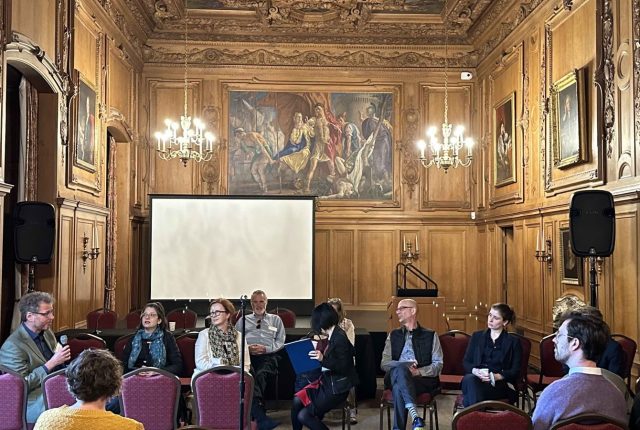
On February 2, 2024, the scholarly conference “Eco Edo: Ecological Perspectives on Early Modern Japanese Art” was held, serving as a pivotal second event in the “Open Edo: Diverse, Ecological, and Global Perspectives on Japanese Art, 1603–1868” series, organized by the Center for 17th- & 18th-Century Studies. This year-long 2023-24 Core Program brought together six distinguished scholars to engage in rich dialogues that extended the understanding of premodern ecology within the Japanese archipelago during the Edo period.
The conference began with a panel that reexamined well-known paintings and genres through an ecological lens. Gregory Levine (UC Berkeley) opened the dialogue with his presentation, “‘Close Looking,’ but at What? Hasegawa Tōhaku’s Pine Grove and ‘Attentional Deviance’.” Levine introduced the concept of “attentional deviance,” challenging the audience with thought-provoking inquiries about the focus of our gaze in Hasegawa Tōhaku’s celebrated masterpiece. His insightful commentary prompted attendees to view the iconic Pine Grove not just as an artistic marvel but as an ecological record, thereby fostering a deeper historical, ethical, and ecological awareness of the painting and its contemporary relevance. Rachel Saunders (Harvard Art Museums) further enriched this dialogue with her presentation, “The Birds, Flowers, and Botany of Edo Rinpa.” Through a meticulous examination of flora and fauna paintings by Kyoto Rinpa artists Sakai Hōitsu and Suzuki Kiitsu, Saunders explored how these 18th-century artists captured new botanical and zoological details, reflecting the evolving relationship between humans and the natural world.
The conversation expanded to include more nuanced case studies with the second panel, such as Chelsea Foxwell’s (University of Chicago) inquiry into the presence of insects in Edo-period artwork in her presentation, “What Are Bugs Doing in Edo-Period Paintings?” Foxwell advocated for a more interactive engagement with these paintings beyond mere symbolic interpretation, highlighting the ecological themes of diversity, triviality, and interconnectedness. Kit Brooks (National Museum of Asian Art) further explored this theme with a focus on wolf imagery in “Morphing into Madness: Shifting Perceptions of the Japanese Wolf.” Brooks presented a captivating array of wolf paintings, illustrating how changing depictions of wolves throughout early modern Japanese history mirrored shifting human perceptions and ecological anxieties.
The final panel shed light on the environmental landscapes of the Edo period through examination of garden spaces. Christian Tagsold (Heinrich Heine University), in his presentation “The Thousand Gardens of Edo: Exploring the Nature of the Cultivated Environment,” delved into the cultural significance of Daimyō gardens, revealing insights into premodern Japanese attitudes towards nature and urbanization. Complementing this, Nobuko Toyosawa (Oriental Institute of the Czech Academy of Sciences) presented “The Place of Ecology in Matsudaira Sadanobu’s Gardens,” offering a penetrating analysis of Sadanobu’s eco-cultural practices and their implications for governance and landscape design in Shirakawa.
The “Eco Edo” conference marked a pivotal advancement in Japanese art historical studies, expanding the scope of analysis of the Edo period’s ecological dimensions. Held at the William Andrews Clark Memorial Library, the event facilitated a dynamic exchange among
leading scholars and attendees in plenary discussion, integrating ecological themes into current issues, including museum conservation practices. The “Open Edo” series promises to further expand the horizons of Edo studies with its upcoming event, “Edo Outsiders: Ainu and Ryūkyūan Art,” scheduled for April 19.
-Heeyeun Kang, Ph.D. Student, Department of Art History, UCLA

